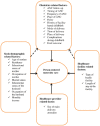Person-centered maternity care during childbirth and associated factors among mothers who gave birth at public health institutions of Debre Markos town, Northwest Ethiopia, 2022: A cross-sectional study
- PMID: 38249947
- PMCID: PMC10798133
- DOI: 10.1177/20503121231225352
Person-centered maternity care during childbirth and associated factors among mothers who gave birth at public health institutions of Debre Markos town, Northwest Ethiopia, 2022: A cross-sectional study
Abstract
Background: Person-centered maternity care is a crucial scheme for a positive childbirth experience. It enhances facility-based delivery, improves patient-provider communication, and increases women's satisfaction. However, there is limited evidence on the magnitude of person-centered care and certain variables were missed in Ethiopia. Therefore, this study assessed the magnitude of person-centered maternity care during childbirth and associated factors at health institutions of Debre Markos town, Ethiopia.
Methods: Institution-based cross-sectional study was conducted at public health institutions of Debre Markos town. Participants were enrolled using systematic random sampling technique. Data were collected through face-to-face exit interviews, cleaned, coded, and entered into Epi-Data version 3.1 then exported to SPSS version 25 for analysis. After generating simple linear regression analysis, variables with p-value ⩽ 0.25 were fitted into multivariable linear regression model and p-value < 0.05 was declared statistically significant with 95% CI for β. Finally, study findings were presented using texts, tables, and figures.
Results: In this study, 380 women participated, with a response rate of 98.19%. The respondent's mean person-centered maternity care score was 56.83 with 95% CI: (55.83, 57.83). Mean score for sub-scale was 15.08 for dignity and respect, 14.42 for communication and autonomy, and 27.33 for supportive care. Commencing antenatal care during third trimester (β = -4.86, 95% CI: -8.22, -1.49), caesarean delivery (β = -5.78, 95% CI: -7.68, -3.87), college and above educational level of women (β = 3.75, 95% CI: 1.11, 6.39), being multiparous (β = 3.69, 95% CI: 1.85, 5.55), and health center delivery (β = 6.59, 95% CI: 4.17, 9.02) were factors significantly associated with person-centered maternity care.
Conclusion: This study showed person-centered maternity care was low compared with World Health Organization standards. This informs local policymakers, district health offices, institutional healthcare administrators, and healthcare professionals of the discrepancies in achieving international standards of quality care.
Keywords: Childbirth; Debre Markos; Ethiopia; person-centered maternity care.
© The Author(s) 2024.
Conflict of interest statement
The author(s) declared no potential conflicts of interest with respect to the research, authorship, and/or publication of this article.
Figures



Similar articles
-
Person-centered maternity care during childbirth and associated factors at selected public hospitals in Addis Ababa, Ethiopia, 2021: a cross-sectional study.Reprod Health. 2022 Oct 4;19(1):199. doi: 10.1186/s12978-022-01503-w. Reprod Health. 2022. PMID: 36195884 Free PMC article.
-
Determinants of person-centered maternity care at the selected health facilities of Dessie town, Northeastern, Ethiopia: community-based cross-sectional study.BMC Pregnancy Childbirth. 2020 Sep 10;20(1):524. doi: 10.1186/s12884-020-03221-2. BMC Pregnancy Childbirth. 2020. PMID: 32912244 Free PMC article.
-
Person-centered care during childbirth and associated factors among mothers who gave birth at health facilities in Hawassa city administration Sidama Region, Southern Ethiopia.BMC Pregnancy Childbirth. 2022 Jul 22;22(1):584. doi: 10.1186/s12884-022-04909-3. BMC Pregnancy Childbirth. 2022. PMID: 35869484 Free PMC article.
-
COVID-19 vaccine acceptability and determinants among pregnant mothers attending antenatal care services at Debre Markos town public health institutions, Debre Markos Northwest Ethiopia: mixed study.Pan Afr Med J. 2022 Apr 12;41:293. doi: 10.11604/pamj.2022.41.293.32618. eCollection 2022. Pan Afr Med J. 2022. PMID: 35855042 Free PMC article.
-
Respectful maternity care and associated factors among mothers who gave birth at public health institutions in Debre Tabor town, Northwest Ethiopia: a mixed-methods study.Front Glob Womens Health. 2025 Jan 23;6:1513906. doi: 10.3389/fgwh.2025.1513906. eCollection 2025. Front Glob Womens Health. 2025. PMID: 39917179 Free PMC article.
Cited by
-
Factors associated with respectful maternity care reported by patients in selected health facilities in Musanze District, Rwanda: a facility-based cross-sectional study.BMC Womens Health. 2025 May 27;25(1):259. doi: 10.1186/s12905-025-03803-2. BMC Womens Health. 2025. PMID: 40426106 Free PMC article.
-
Assessment of the person-centered maternity care scale: a global systematic review.EClinicalMedicine. 2025 Mar 20;82:103145. doi: 10.1016/j.eclinm.2025.103145. eCollection 2025 Apr. EClinicalMedicine. 2025. PMID: 40201797 Free PMC article.
-
Person-centred maternity care during childbirth: a systematic review in low and middle-income countries.BMC Pregnancy Childbirth. 2025 Feb 12;25(1):147. doi: 10.1186/s12884-024-07133-3. BMC Pregnancy Childbirth. 2025. PMID: 39939934 Free PMC article.
References
LinkOut - more resources
Full Text Sources

